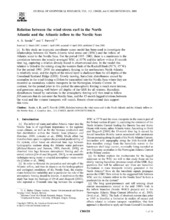Relation between the wind stress curl in the North Atlantic and the Atlantic inflow to the Nordic Seas
Journal article

Åpne
Permanent lenke
https://hdl.handle.net/1956/2729Utgivelsesdato
2008-06-27Metadata
Vis full innførselSamlinger
- Geophysical Institute [1185]
Originalversjon
https://doi.org/10.1029/2007jc004236Sammendrag
In this study an isopycnic coordinate ocean model has been used to investigate the relationships between the North Atlantic wind stress curl (WSC) and the inflow of Atlantic water to the Nordic Seas. For the period 1995–2001, there is a maximum in the correlation between the zonally averaged WSC at 55!N and the inflow with a 15-month time lag, capturing a relation already found in observational data. In the model this relation is linked to the mixing along the western flank of the Rockall Bank (56!N, 15!W). For the period 1995–2001 the atmospheric forcing in the northeastern North Atlantic is relatively weak, and the depth of the mixed layer is shallower than the sill depths of the Greenland-Scotland Ridge (GSR). Slowly moving, baroclinic disturbances caused by anomalies in the wind forcing will then be transmitted into the Nordic Seas where they are recorded as anomalous volume transports in the Norwegian Atlantic Current. In contrast, for the pentad prior to this period the atmospheric forcing is much more intense, and generates mixing well below sill depths of the GSR for all winters. Baroclinic disturbances forced by variations in the atmospheric forcing will then tend to follow f/H contours that do not enter the Nordic Seas, and the 15-month lagged relations between the wind and the volume transports will vanish. Recent observational data support this view.
Utgiver
American Geophysical UnionSerie
Journal of Geophysical Research: Oceans113(C06028)